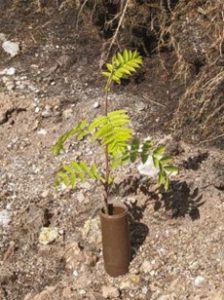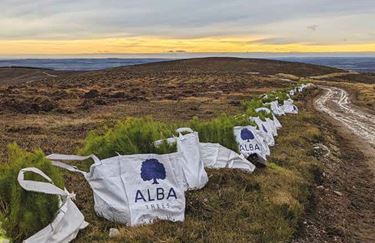FWN38 Autumn 2022 – An Update on Carbon Markets (June 2022)
14 December 20221. What are Carbon Credits, and how do they work?
Carbon Credits are, in their simplest form, a method to quantify and assign an ownership to one metric tonne of carbon dioxide equivalent which has been removed from the atmosphere in the form of a certificate, or “credit”.
This method to quantify carbon capture and to assign ownership to this “capture”, then enables the measurable offsetting of an individual or company’s emissions, and also facilitates trading of these units for those that may have units to spare (or those who generate units for sale).
Carbon credits are a great example of natural capital financing, which is where financial investment is used as a means to conserve or enhance the value of the natural environment.
Two examples could be a farmer planting a shelterbelt or riparian woodland which would otherwise not have been financially viable for them without this additional income generated by selling carbon credits generated by their new woodland, or it could be the funding of a restoration project of degraded peatland on an estate which is financed by carbon credit generation. Both of these projects would allow the carbon buyer to claim offsetting of their emissions, and for the seller to secure funding which would otherwise be unavailable through other means.
As a principle, this is a great concept. Businesses and individuals who are conscious of their impact on the wider environment have a means to make measurable mitigations to balance their emissions, and the payment for these mitigations then can be used to deliver a “greater good” to the environment and to rural businesses.
2. How big a part of farming and crofting are they likely to become?
At present, it’s hard to say how big a part carbon credits will play in the future for farming and crofting. Carbon markets are still relatively young within the UK (the Woodland Carbon Code for example was only established in 2011), and these markets are evolving rapidly as demand and policies change and adapt. Policy will be key in this discussion, both now and in the future. We’re seeing a huge increase in focus from every area of the market- everyone is now paying far greater attention to our impact on climate change (with this brought into sharp focus with last years’ IPCC report and COP26 being hosted in Glasgow), and this is driving a number of changes- increased appetite for woodland creation being one of these.
All costs are rising faster than income at present, particularly the costs of labour, fuel, fertiliser and fencing, and the pace of these cost rises is faster than the grant rates can adjust to even come close to these costs.
As such, for many smaller projects, these only really become financially viable with the injection of carbon capital during early years.
As more consumers and companies also look to measure their own carbon footprints, we’re also seeing more suppliers being asked to provide carbon footprints for their produce. It wouldn’t be a huge leap to assume that we’ll see farmers being asked to provide these carbon footprints more regularly in the future, nor would it be outrageous to suggest that some sectors may be asked to make the effort to bring emissions down, or offset any emissions which cannot be reduced.
Carbon markets are currently very influential within the UK market for rural industries, but the main influence these rapidly climbing carbon prices are having is that they are driving up the land purchase prices for those looking to buy potentially plantable land.
This is causing real conflict in land use as farmers are having to compete for land against overseas buyers and investment firms when looking to buy farmland- a worrying situation for the rural communities dependant on farming and crofting for their livelihoods.
3. What are the options facing crofters/farmers?
For those who qualify for carbon credit sales and who register their projects at the outset, there are a multitude of options.
Carbon Credits can be sold in two basic forms – as a Pending Issuance Unit, which is a prediction of carbon sequestration, or as a Woodland Carbon Unit (or Peatland Carbon Unit depending on what activity these are generated from), which is a carbon unit of 1 tCO2e which has been delivered already and has been confirmed to have been captured by a third party auditor.
It is possible to register a project yourself (although some help may be needed from a consultant or advisor with some of the science and calculations), or it is more common to register a project with a consultancy firm or a carbon broker firm.
Farmers and landowners can generate units by either planting trees or restoring peat at present, and these units can then be either retained, sold up front, sold at a later date, or used to offset the owners’ own carbon emissions. It is possible to use two or more of these options in combination, and the decision on what and how to sell should be made carefully and only after all factors have been fully considered.
4. What do you say to farmers and crofters who are faced with the choice of keeping or selling off any schemes they have or are planning on having?
Carbon credits can offer a great opportunity for farmers and crofters to fund projects through the benefits of natural capital accounting, but those looking to potentially sell units should go into this process aware of all the facts and options before signing any contracts. By their very nature, carbon credit agreements are long-duration contracts (in excess of 30 years), and a lot can change
in that space of time- policy, grants, land and carbon values, and ownership (multiple generations of land managers may be tied in by same contract if not careful).
For a woodland carbon scheme, you are making a permanent land use change- any areas you plant will likely be in trees forever more, so make sure a scheme is in the right place, and that you have clear objectives and goals, not just a desire to join a green goldrush.
Seek independent, impartial and professional advice from a consultant or advisor who understands your business and your objectives, and do not be pressured into any sales. Read your contracts, be fully aware of all the terms and conditions, and if you don’t understand (or if you don’t agree with any), raise it prior to signing. If you feel that selling carbon is right for you, only sell what you feel you can afford to do so- both present-day, and many years down the line too. A unit can only be sold once, so do not sell everything up front if you may later require units to offset your own business emissions.
Any scheme takes time to develop properly, to conduct surveys, carry out design and consultation, etc – do not expect (or try) to rush the process and deliver a half-baked scheme, rather take the time to develop a scheme properly, to identify your key objectives and constraints, and to build a model which works for you.
5. The market’s been referred to as the “wild west” – How important is effective regulation going forward?
As an industry, we need to draw clear distinctions between the regulated and accredited markets which exist in the UK (the Woodland Carbon Code and the Peatland Carbon Code), and those new and evolving markets such as soil carbon and blue carbon to name but two which have yet to evolve their own quality assurance standard. For the two established markets in the UK (WCC & PCC) there is effective regulation in place which ensures these schemes benefit from a high level of confidence in them which is recognised globally. Effective regulation prevents double-selling, quantifies and independently verifies the units generated by each scheme using professional auditors, and has strict eligibility criteria in place to ensure that projects genuinely qualify for carbon funding.
Where the “Wild West” comes in is the markets which are out with these established codes, where we have questionable practises being applied and claims being made without the science, the auditing or the quality assurance to back these up.
Effective regulation of these markets is vital going forward. Too tight a grip and the accelerating pace we’re seeing across the industry and the delivery of so much good for the environment and economy at present (bringing us close to our tree planting targets amongst many other benefits) stalls and dies. Too loose a regulatory grip and we see the credibility of the units generated/sold being drawn into question. There must be a balance struck, and this must be constantly reviewed to ensure that in this rapidly changing world, these carbon markets don’t lose their connection with the initial reason they were created- to fund positive environmental change and work to address our climate emergency.
Ben Law, SAC Consulting
Sign up to the FAS newsletter
Receive updates on news, events and publications from Scotland’s Farm Advisory Service


